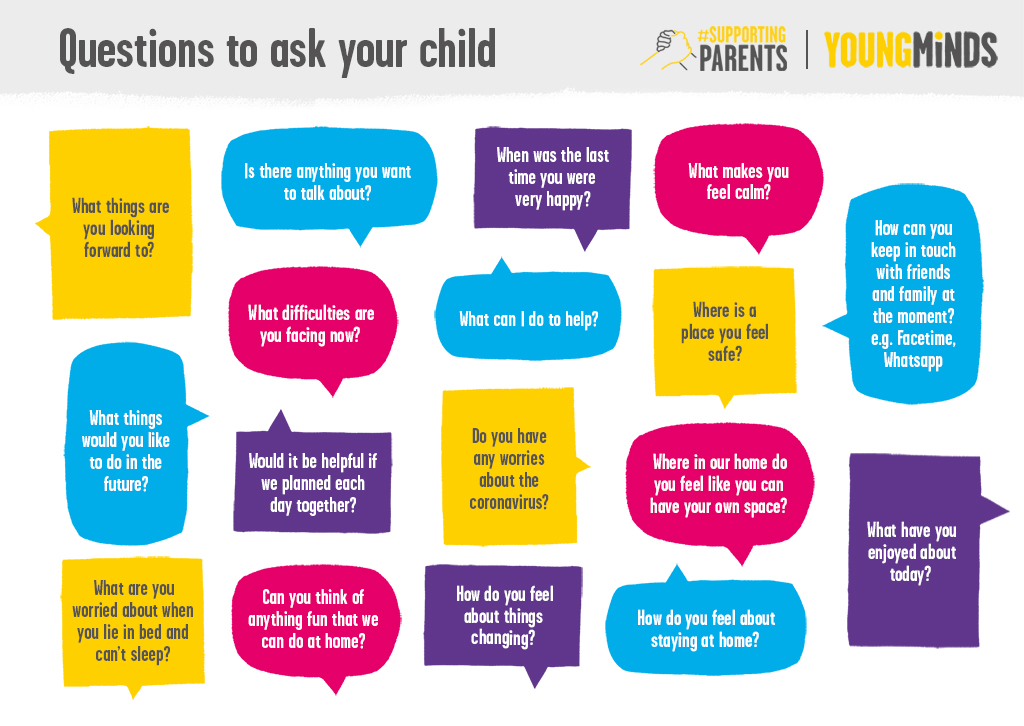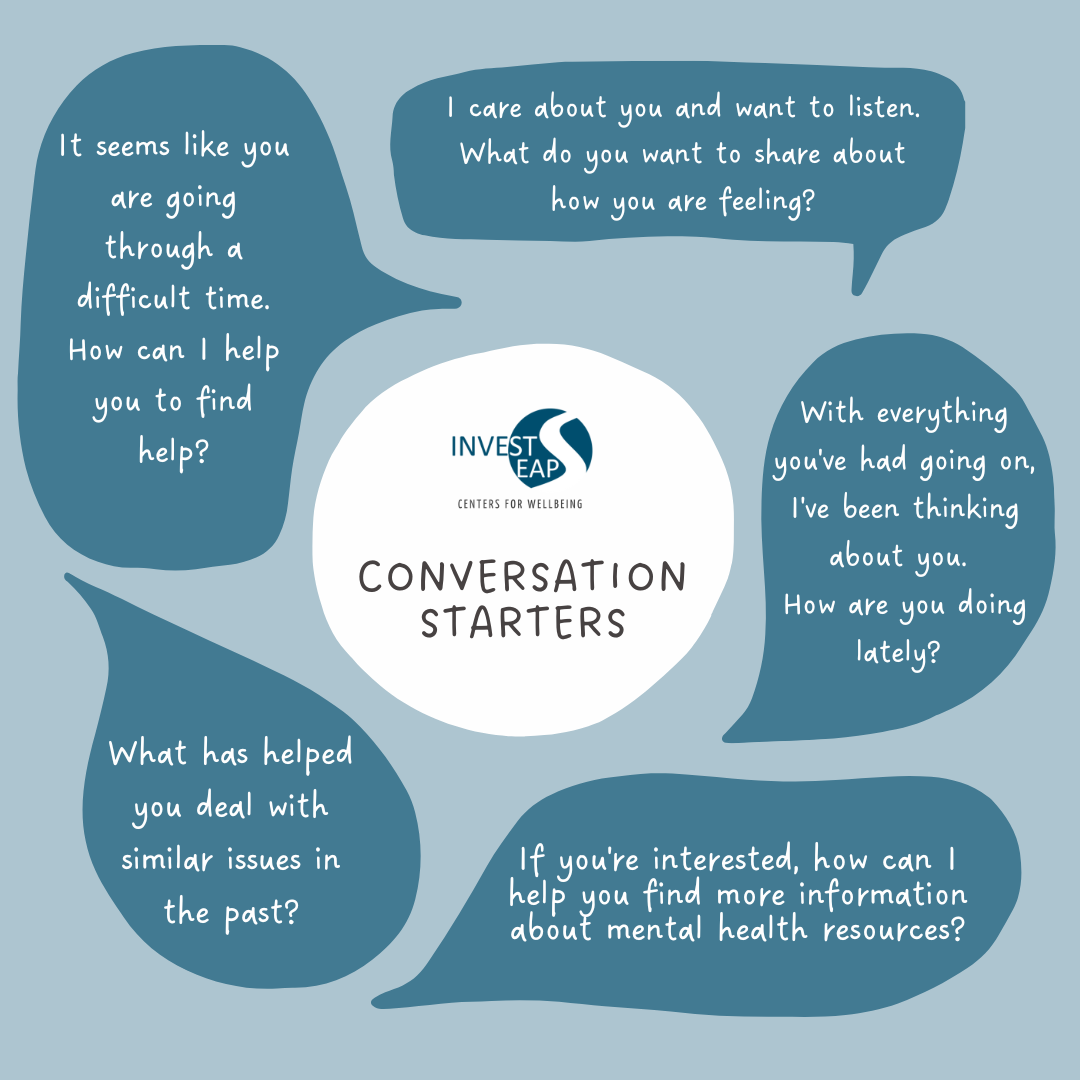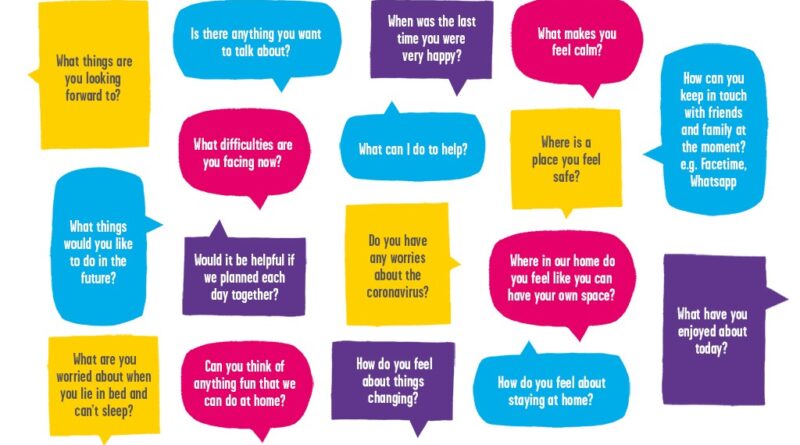What Are a Few Mental Health Conversation Starters: Effective Tips
Talking about mental health can be tough. But it’s important for everyone.
Good conversation starters make it easier to discuss mental health. They can help break the ice and encourage openness. Many people struggle to find the right words or worry about saying the wrong thing. Having a few go-to phrases can make a big difference.
These starters can help you support friends or family. They can also help you understand your own feelings better. Let’s explore some simple ways to begin these important conversations.

Importance Of Mental Health
Talking about mental health is vital. It helps us understand each other better. When we start these conversations, we break down barriers. We create safe spaces. So, what are a few mental health conversation starters? Before diving into that, let’s explore the importance of mental health.
Impact On Daily Life
Mental health affects every part of our lives. It influences how we think, feel, and act. If someone is struggling, it can show in different ways:
- Difficulty concentrating
- Changes in sleep patterns
- Loss of interest in daily activities
- Increased irritability or anxiety
These symptoms can make daily tasks hard. For example, a person with anxiety might find it hard to focus at work. They might also avoid social situations. This can lead to isolation. It can affect their relationships and job performance. Understanding mental health helps us support each other. We can recognize when someone is struggling. We can offer help or just listen. Small acts of kindness can make a big difference. Here is a simple table to show how mental health impacts different areas of life:
| Area of Life | Impact of Poor Mental Health |
|---|---|
| Work | Reduced productivity, frequent absences |
| Relationships | Increased conflicts, withdrawal from loved ones |
| Physical Health | Chronic stress, weakened immune system |
Stigma Reduction
Stigma around mental health is a big problem. People often feel ashamed to talk about their struggles. This can stop them from seeking help. Reducing stigma is crucial. It encourages open conversations. Here are some ways to reduce stigma:
- Educate yourself and others. Learn about mental health conditions.
- Use respectful language. Avoid terms that can hurt or belittle someone.
- Share your own experiences. Personal stories can inspire others to speak up.
- Support mental health initiatives. Join campaigns or events that promote awareness.
When we reduce stigma, we create a more accepting world. People feel safe to share their feelings. They are more likely to seek help. Remember, mental health is as important as physical health. By talking about it, we show that it’s okay to seek help. We build a supportive community. We can all play a part in this. Start the conversation today. Ask someone how they are really doing. Listen without judgment. You never know how much it might help.

Creating A Safe Space
Talking about mental health can be tough. Creating a safe space is crucial for these conversations. This space helps people feel comfortable and understood. It also encourages openness. There are a few steps to make this happen.
Setting The Tone
Setting the right tone is key to creating a safe space. Your tone should be calm and supportive. Here are a few tips:
- Be Genuine: Show that you care and are there to listen.
- Use Empathy: Try to understand their feelings. Phrases like “I understand this is hard for you” can help.
- Avoid Judgement: Keep your opinions to yourself. Focus on listening.
- Be Patient: Give the person time to share. Do not rush them.
- Use Open-Ended Questions: This encourages more sharing. For example, “How have you been feeling lately?”
A calm and supportive tone can help the other person feel safe. It shows them that they can trust you. They will be more likely to open up.
Choosing The Right Environment
The environment also plays a big role. A good environment can make the person feel more at ease. Here are some tips to choose the right place:
- Pick a Quiet Place: Avoid noisy or crowded areas. A quiet place helps the person focus on the conversation.
- Ensure Privacy: Make sure the place is private. This helps the person feel safe to share personal thoughts.
- Comfortable Setting: Choose a place with comfortable seating. It can be a cozy room or a peaceful park.
- Neutral Ground: Sometimes, a neutral place is best. This could be a café or a library where both feel equal.
- Be Flexible: Let the person choose the place if they prefer. This can make them feel more in control.
A good environment sets the stage for a meaningful conversation. It helps both of you focus on the topic. It also shows respect for the other person’s feelings.
Open-ended Questions
Having conversations about mental health is important. Open-ended questions can help make these talks easier. They allow people to express their feelings without feeling judged. These questions don’t have a simple “yes” or “no” answer. Instead, they encourage sharing and deeper conversations.
Encouraging Sharing
Open-ended questions are great for encouraging sharing. They show that you care about the other person’s feelings and thoughts. When people feel heard, they are more likely to open up. Here are some ways open-ended questions can help:
- Create a safe space: When you ask open-ended questions, it shows that you are open to listening. This can make the other person feel safe to share their thoughts.
- Encourage detailed responses: These questions require more than a simple answer. This can lead to a deeper understanding of the other person’s feelings.
- Foster a connection: Sharing personal experiences can help build a stronger bond between people. It shows empathy and understanding.
Using open-ended questions can be a powerful way to support someone’s mental health. It lets them know that they are not alone. Here is a table that shows the difference between open-ended and closed-ended questions:
| Closed-Ended Question | Open-Ended Question |
|---|---|
| Are you feeling okay? | How are you feeling today? |
| Did you have a good day? | What was your day like? |
| Do you need help? | What can I do to support you? |
Examples Of Questions
Here are some examples of open-ended questions that can help start a conversation about mental health:
- How have you been feeling lately? This question is general and lets the person share as much or as little as they want.
- What has been on your mind? This shows that you are interested in their thoughts and feelings.
- Can you tell me more about what’s been happening? This encourages the person to provide details about their situation.
- What do you find helps you when you’re feeling down? This can lead to a discussion about coping mechanisms and support.
- How can I be there for you? This shows that you are willing to help and support them.
Using these questions can help create a supportive environment. It shows that you care about the other person’s mental health. This can lead to more open and honest conversations. Remember, the goal is to listen and be there for the person. Your support can make a big difference in their life.

Using Current Events
Engaging in conversations about mental health can be challenging. Using current events as conversation starters can make these discussions more natural and relatable. Current events provide shared context and can help bridge the gap between general topics and personal experiences. Here are a few ways to incorporate current events into mental health conversations.
Relevance To Personal Experience
Linking current events to personal experiences makes the conversation more meaningful. Here are some tips to make it relevant:
- Identify common experiences: Choose events that many people can relate to, like changes in work conditions or public health updates.
- Share your own story: Relate the event to your personal experience. For example, “I’ve found working from home challenging. How has it been for you?”
- Ask open-ended questions: These invite more detailed responses. For instance, “The recent news about mental health in athletes got me thinking. What are your thoughts on it?”
Consider this table for a quick reference:
| Event Type | Potential Conversation Starter |
|---|---|
| Workplace Changes | “How has the shift to remote work affected you?” |
| Health News | “Did you hear about the recent study on sleep and mental health? What do you think?” |
| Sports News | “The discussion on athletes’ mental health is interesting. Do you follow any sports?” |
Recent News Topics
Staying updated with recent news can provide fresh topics for discussion. Here are some recent news themes to consider:
- Public Health Updates: News about mental health initiatives or public health measures can be great conversation starters.
- Celebrity Stories: Many celebrities share their mental health journeys. These stories can help normalize mental health discussions.
- Scientific Studies: New research findings on mental health can provide factual bases for conversation.
Here are some examples:
- Recent Mental Health Campaigns: “Have you seen the new campaign on mental health awareness? It made me think about how important it is to talk about it.”
- Celebrity Mental Health Stories: “I read about a celebrity sharing their struggles with anxiety. It feels good knowing even they face such issues.”
- New Research Findings: “A new study on the impact of social media on mental health just came out. What do you think about it?”
Using current events as conversation starters can make discussing mental health easier and more engaging. Keep the conversation relevant and up-to-date.
Empathy In Conversations
Talking about mental health can be tough. Yet, it is important. Using empathy in conversations can make a huge difference. This means listening and showing care. It helps the other person feel safe and understood. Here are some tips on how to show empathy in your conversations about mental health.
Active Listening Techniques
Active listening shows that you care. It is more than just hearing words. It means paying attention and responding. Here are some techniques:
- Maintain eye contact: This shows that you are focused on the person speaking.
- Nod and use small verbal cues: Words like “yes” or “I see” help show you are engaged.
- Avoid interrupting: Let the person finish their thoughts. This shows respect and patience.
Using these techniques can foster trust. The person will feel valued and heard. You can also use a table to remember key points:
| Technique | Description |
|---|---|
| Eye Contact | Show that you are focused and present. |
| Verbal Cues | Use small words to show you are listening. |
| Do Not Interrupt | Let the person finish their thoughts. |
Remember, active listening is about showing you care. It is a key part of empathy in conversations.
Showing Support
Showing support is crucial in mental health talks. It helps the person feel they are not alone. Here are some ways to show support:
- Validate their feelings: Say things like, “It’s okay to feel this way.”
- Offer help: Ask, “How can I support you?” This shows you are willing to help.
- Follow up: Check in with them later. Ask how they are doing.
These actions show you care. They help build a supportive environment. Here is a simple table to remember these points:
| Action | Example |
|---|---|
| Validate Feelings | “It’s okay to feel this way.” |
| Offer Help | “How can I support you?” |
| Follow Up | “How are you doing now?” |
Showing support is not hard. It just takes some care and time. Empathy in conversations can make a big difference. It helps the person feel understood and supported.
Body Language Cues
Talking about mental health can be tough. Often, people struggle with how to start. Body language cues can help you start a mental health conversation. They are non-verbal signals that show how someone feels. Understanding these cues can make the conversation easier and more comfortable for both of you.
Non-verbal Signals
Non-verbal signals are crucial in conversations. They help you understand the other person’s feelings. Here are a few common non-verbal signals to look for:
- Eye Contact: Lack of eye contact can mean the person feels anxious or uncomfortable.
- Body Posture: Slouched shoulders or crossed arms may indicate sadness or defensiveness.
- Facial Expressions: Frowning, crying, or a blank expression can show distress or sadness.
- Gestures: Fidgeting or tapping can be a sign of nervousness or stress.
It is important to pay attention to these signals. They can help you understand the other person better. This understanding can guide your conversation and make it more meaningful. Consider this simple table to summarize non-verbal signals and their possible meanings:
| Non-Verbal Signal | Possible Meaning |
|---|---|
| Eye Contact | Anxiety, Discomfort |
| Body Posture | Sadness, Defensiveness |
| Facial Expressions | Distress, Sadness |
| Gestures | Nervousness, Stress |
Creating Comfort
Creating a comfortable space for conversation is key. It helps the person feel safe and open up. Here are some tips to create comfort:
- Choose a Quiet Place: A quiet place with few distractions helps the person focus on the conversation.
- Be Patient: Give the person time to gather their thoughts. Do not rush them.
- Show Empathy: Use phrases like “I understand” or “That sounds tough” to show you care.
- Maintain Open Body Language: Keep your body relaxed and your arms open. This shows you are approachable.
- Use a Soft Tone: Speak in a calm and soft tone. It helps the person feel safe.
Remember, the goal is to make the person feel comfortable. A comfortable person is more likely to open up. This makes the conversation more effective. Here is a quick checklist to summarize how to create comfort:
| Action | Purpose |
|---|---|
| Choose a Quiet Place | Minimize Distractions |
| Be Patient | Give Time to Think |
| Show Empathy | Show You Care |
| Maintain Open Body Language | Be Approachable |
| Use a Soft Tone | Make the Person Feel Safe |
Follow-up Questions
Mental health is a topic that is becoming more important in our daily conversations. Starting these conversations can be challenging, but follow-up questions can make them more meaningful. These questions help to show that you care and are listening. Here are some tips on how to deepen the conversation and show interest through follow-up questions.
Deepening The Conversation
To deepen a mental health conversation, ask questions that encourage the other person to share more. Open-ended questions are the best for this. They allow the person to express their feelings and thoughts in detail. Some examples of these questions include:
- Can you tell me more about that?
- How did that make you feel?
- What do you think is causing this feeling?
These questions do not have simple yes or no answers. They require the person to reflect and share more about their experiences. This can help you understand them better and provide the support they need. Another way to deepen the conversation is to use reflective listening. This means repeating what the person has said in your own words. This shows that you are listening and helps clarify their feelings. For example:
Person: “I have been feeling really stressed at work lately.” You: “It sounds like work has been very stressful for you.”
Reflective listening can make the person feel heard and understood. It can also encourage them to share more about their situation.
Showing Interest
Showing interest in the other person’s feelings is important. It builds trust and makes them feel valued. One way to show interest is by asking follow-up questions that are specific to what they have shared. For example:
- “You mentioned feeling anxious lately. What do you think triggers your anxiety?”
- “You said you were feeling down. Have you noticed any patterns with these feelings?”
These questions show that you are paying attention and care about their well-being. They also encourage the person to think more about their feelings and experiences. Another way to show interest is through non-verbal cues. Nodding, maintaining eye contact, and leaning forward can show that you are engaged in the conversation. These actions can make the person feel more comfortable and willing to share. Here is a table summarizing some key points:
| Technique | Example |
|---|---|
| Open-ended Questions | “Can you tell me more about that?” |
| Reflective Listening | “It sounds like work has been very stressful for you.” |
| Specific Follow-up | “You mentioned feeling anxious lately. What do you think triggers your anxiety?” |
Showing interest and deepening the conversation can make a big difference. It helps the other person feel supported and understood. These techniques can lead to more meaningful and helpful conversations about mental health.
Ending On A Positive Note
Ending a conversation on mental health with a positive note can leave a lasting impact. It is crucial to uplift and inspire hope in those who may be struggling. This section will explore how to provide encouragement and hope, and where to find resources for further support.
Encouragement And Hope
When discussing mental health, it is vital to end the conversation with encouraging words. Doing so can help the individual feel valued and understood. Here are a few ways to offer encouragement and hope:
- Acknowledge their bravery: Recognize their courage for speaking about their struggles. Phrases like “I admire your strength in talking about this” can be very affirming.
- Remind them they are not alone: Let them know that many people face similar challenges. Statements such as “You are not alone in this” can be comforting.
- Focus on their progress: Highlight any positive steps they have taken. Say things like “I see how hard you are trying, and it is inspiring.”
- Offer your support: Assure them you are there for them. Simple words like “I am here for you” can make a big difference.
Encouragement can also be conveyed through positive affirmations. Here is a table of affirmations that can be shared:
| Affirmation | Purpose |
|---|---|
| You are capable of great things. | Boosts self-esteem and confidence. |
| Every step you take is progress. | Reminds them that small steps matter. |
| Your feelings are valid and important. | Validates their emotions. |
| It is okay to ask for help. | Encourages seeking support. |
Resources For Further Support
Providing resources can empower individuals to seek the help they need. Below are some resources that can be shared:
- National Helplines: Many countries have helplines that offer immediate support. For example, in the US, the National Suicide Prevention Lifeline is available at 1-800-273-8255.
- Online Counseling Services: Websites like BetterHelp and Talkspace offer online therapy with licensed professionals. This can be a convenient option for many.
- Local Mental Health Organizations: Encourage them to look for local organizations that provide mental health services. These organizations often offer counseling, support groups, and other resources.
Here is a table with some useful resources:
| Resource | Contact Information |
|---|---|
| National Suicide Prevention Lifeline | 1-800-273-8255 |
| BetterHelp | www.betterhelp.com |
| Talkspace | www.talkspace.com |
| NAMI (National Alliance on Mental Illness) | www.nami.org |
Sharing these resources can provide a sense of direction and hope. It shows that help is available and accessible. By offering these tools, you can help them take the next step toward improving their mental health.
Frequently Asked Questions
What Are Good Mental Health Conversation Starters?
Good starters include asking how someone’s day was or sharing your own feelings. Open-ended questions work best.
How To Begin A Mental Health Discussion?
Start with a simple question about their well-being. Be genuine and empathetic in your approach.
Why Are Mental Health Conversations Important?
These conversations help reduce stigma and provide support. They can lead to better understanding and assistance.
How To Talk About Mental Health At Work?
Approach the topic with sensitivity. Use private settings and express genuine concern for their well-being.
Conclusion
Starting a mental health conversation can seem difficult. These starters can help. Use them to create a safe space. Encourage open dialogue and active listening. Your support can make a difference. Remember, small steps lead to big changes. Everyone deserves to feel heard and understood.
Start the conversation today. You might be the lifeline someone needs. Prioritize mental health and show you care. Every word counts.



